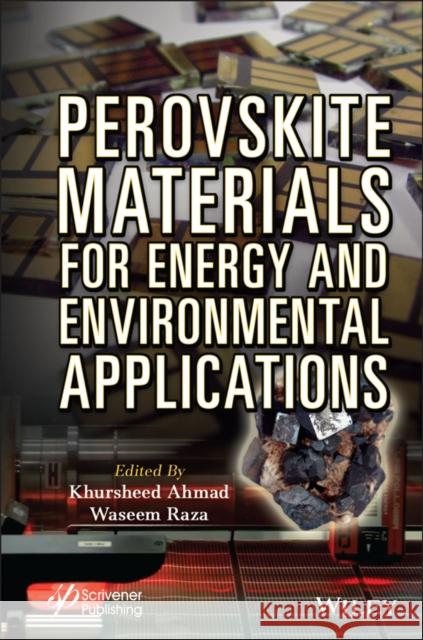Perovskite Materials for Energy and Environmental Applications » książka



Perovskite Materials for Energy and Environmental Applications
ISBN-13: 9781119760276 / Angielski / Twarda / 2022 / 336 str.
Perovskite Materials for Energy and Environmental Applications
ISBN-13: 9781119760276 / Angielski / Twarda / 2022 / 336 str.
(netto: 720,76 VAT: 5%)
Najniższa cena z 30 dni: 752,14
ok. 30 dni roboczych
Dostawa w 2026 r.
Darmowa dostawa!
Preface xi1 Computational Approach for Synthesis of Perovskite Solar Cells 1A.S. Mathur and B.P. Singh1.1 Introduction 21.2 Preliminary Steps 21.3 Advanced Semiconductor Analysis (ASA) 151.4 Analysis of Microelectronic and Photonic Structures (AMPS) 201.5 Automat for Simulation of Heterostructures (AFORS-HET) 231.6 Solar Cell Capacitance Simulator (SCAPS) 261.7 Conclusion 31References 322 Fundamentals of Perovskite Solar Cells 37Neha Patni, Rokadia Zulfiqar and Krishna Patel2.1 Introduction 372.2 Structure 402.3 Working Mechanism of PSC 422.4 Device Architecture 432.4.1 Mesoporous Structure 432.4.2 Planar Heterostructures 452.5 Properties 462.5.1 High Optical Absorption 462.5.2 High Open-Circuit Voltage 472.5.3 Low Recombinations 482.5.4 Tunable Bandgap 492.5.4.1 Organic Cation (A) 492.5.4.2 Metal Cation (M) 502.5.4.3 Halide Anion (X) 512.5.5 Rapidly Increasing Efficiency 512.6 Drawbacks and Ongoing Challenges of PSCs 522.7 Conclusion 53Acknowledgment 54References 543 Surface Morphological Effects on the Performance of Perovskite Solar Cells 59Srinivasa Rao Pathipati3.1 Introduction 593.2 Morphology Control 603.2.1 The Effect of Device Architecture on the Morphology and the Device Performance 603.2.2 Effect of Deposition Technique on the Morphology of the Perovskite Layer 623.2.2.1 One-Step Deposition Method 623.2.2.2 Two-Step Deposition Technique 643.2.2.3 Dual-Source Precursor Approach 693.2.2.4 Vacuum Deposition Technique 703.3 Effect of Various Parameters on Growth of Perovskite 713.3.1 Effect of Solvent Additive 713.3.2 Effect of Solid Additive 723.3.3 Seed-Induced Growth of Perovskites 733.3.4 Homogenous Cap-Induced Crystallization 753.3.5 Effect of Hydrophobicity 773.3.6 Effect of Interface Modification 813.3.7 Effect of Solvent Annealing 82References 844 Advanced Synthesis Strategies for Single Crystal Perovskite Halides 91Prerna and Sandeep Arya4.1 Introduction 914.2 Popular Single Crystal Growth Techniques 924.2.1 Anti-Solvent Vapor-Assisted Crystallization (AVC) Method 994.2.2 Inverse Temperature Crystallization (ITC) 1014.2.3 Modified Inverse Temperature Crystallization 1044.2.4 Solution Temperature Lowering Method 1064.2.4.1 Top-Seeded Solution Growth Method 1074.2.4.2 Bottom-Seeded Solution Growth Method 1084.2.5 Bridgman (BG) Method 1104.3 Other Techniques 113Conclusions 117References 1185 Synchrotron-Based Techniques for Analysis of Perovskite Solar Cells 123Umar Farooq, Ruby Phul, Mohd Shabbir, Rizwan Arif and Akrema5.1 Introduction 1245.2 Synchrotron Techniques, Their Limitations and Advantages 1285.3 Synchrotron Radiation X-Ray Diffraction/Scattering (SR-XRD) 1285.4 In Situ XRD 1315.5 Small-Angle X-Ray Scattering 1335.6 Wide-Angle X-Ray Scattering 1355.7 Synchrotron Radiation-Based X-Ray Absorption Techniques 1355.8 X-Ray Absorption Near Edge Structure 1375.9 Extended X-Ray Absorption Fine Structure 1395.10 Conclusions 140References 1426 Recent Progress on Perovskite-Based Solar Cells 147Waseem Raza and Khursheed Ahmad6.1 Introduction 1486.2 Device Structure and Working Principle of PSCs 1526.3 Perovskite-Based Solar Cells 1536.4 Conclusion 161References 1617 BiFeO3-Based Materials For Augmented Photoactivity 167Rashmi Acharya, Lopamudra Acharya and Kulamani Parida7.1 Introduction 1687.1.1 Photocatalytic Water Splitting 1717.1.2 Photocatalytic Conversion of CO2 1717.1.3 Photocatalytic Fixation of Nitrogen 1727.1.4 Selective Organic Transformation for the Synthesis of Fine Chemicals 1727.1.5 Photodegradation of Pollutants 1737.2 Structure, Physicochemical, and Photocatalytic Activity of BiFeO3 1757.3 Elemental Doping in BFO 1777.3.1 PXRD Studies 1777.3.2 Morphological Studies 1787.3.3 XPS Studies 1797.3.4 Optical Property Studies 1807.3.5 Effect of Doping on Photocatalytic Activity of BFO 1827.4 BFO Semiconductor Heterojunction Construction 1837.4.1 Heterojunction Construction With Wide Band Gap Semiconductors 1847.4.2 Heterojunction Construction With Narrow Band Gap Semiconductors 1937.5 Separation Ability and Reproducibility 1987.6 Conclusion and Perspectives 1997.7 Acknowledgement 200References 2018 Photocatalytic Degradation of Pollutants Using ZnTiO3-Based Semiconductor 217Waseem Raza and Khursheed Ahmad8.1 Introduction 2188.2 Synthesis of ZnTiO3 2228.3 Fundamental Need and Basic Mechanism for Photocatalytic Degradation of Pollutants 2238.4 Photocatalytic Degaradation of Pollutants Based on ZnTiO3 2258.5 Conclusion 234References 2359 Types of Perovskite Materials 241Faria Khatoon Naqvi, Yashfeen Khan, Saba Beg and Anees AhmadAbbreviations 2419.1 Introduction 2429.1.2 Types of Perovskite 2439.1.2.1 ABO3 Type of Perovskite Materials 2449.1.2.2 Oxygen and Cation-Deficient Perovskites 2469.1.2.3 Complex Perovskites 2479.1.2.4 Layered Perovskites 248References 25310 Effects of Various Additives to CH3NH3PbI3 Perovskite Solar Cells 257Takeo Oku10.1 Introduction 25710.2 Crystal Structures of Perovskite Halides 25810.3 Basic Configuration of Solar Cells 26010.4 Cl Doping to Perovskites 26610.5 Sb or As Doping to Perovskites 27010.6 Highly (100)-Oriented Perovskites 27410.7 Cu Doping to Perovskites 27910.8 K/FA Doping to Perovskites 28310.9 Morphology Control by Polysilane 29010.10 High-Temperature Annealed Perovskites 29510.11 Conclusion 305Acknowledgements 305References 305Index 317
Khursheed Ahmad, PhD, completed his PhD from the Indian Institute of Technology, Indore, India in 2019. He is currently a Post-Doctoral Fellow at the School of Materials Science and Engineering, Yeungnam University, South Korea. He has published more than 30 research papers as well as 25 book chapters.Waseem Raza, PhD, completed his PhD from Aligarh Muslim University Aligarh, India in 2016. He is currently a Post-Doctoral Fellow in the Department of Materials Science and Engineering, University of Erlangen-Nuremberg, Germany.
1997-2025 DolnySlask.com Agencja Internetowa
KrainaKsiazek.PL - Księgarnia Internetowa









